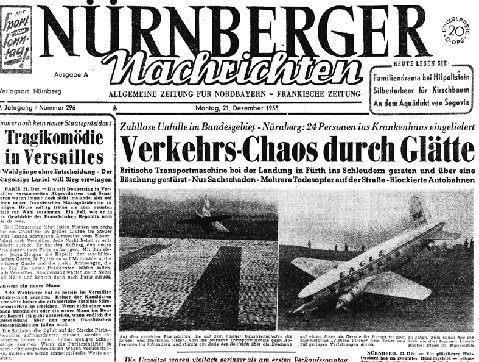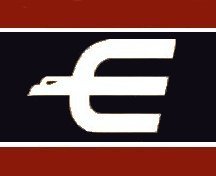
Local Newspaper report of
incident with G-AHPO
"Although there were times
when pilots did undo their safety harnesses in flight, it was
then and still remains a checklist imperative to secure the complete
harness for take-off and landing. On the one occasion when I did
not, I would have been killed had I not been able to fling my
body out of the way of the Control Column as it rammed itself
into the back of my seat. Correctly strapped-in my body would
have been crushed!
Towards the end of 1953 we shared
a contract with another operator to fly pedigree pigs to Yugoslavia.
Five days before Christmas SABENA failed to put on their DC3 and
we were asked to supply another aircraft. This meant using a Viking
and I was given the trip. It promised to be a smooth enough flight
although the weather was far from encouraging.
The route was from Blackbush to Belgrade with a refuelling stop
at Munich where the weather was just above limits - but there
were plenty of alternates available with weather conditions on
or just above alternate minima. The flight would be perfectly
legal but, in fact, there was nowhere really inviting!
Boarding the aircraft I found Reg Peake listening to weather broadcasts
and decoding them. A small pile of his reports was already beginning
to build at the side of my seat long before we started engines.
Like many of his colleagues Reg was not only a first class Radio
Operator but shared with them the quality of being a natural airman
and an enormous asset to any crew having the good fortune to have
them on board. This night he knew how important it was for us
to have a constantly updated picture - and this he provided. Gordon
Burrell (another ex-Mosquito pilot from 140
Wing) was the third member of the operating crew and a young pig-handler
made up the foursome.
The weather picture did not change until we were very close to
Munich when, as one, all airfields within fuel range went below
our limits! We found ourselves in this situation in spite of Reg's
meticulous and constant watch on the position! Not a very pleasant
circumstance but the ILS below us was one with which we were familiar
and the airfield was not an unknown quantity.
Therefore, with no better place to go to, we made an approach
into Munich. I briefed the others, including the pig-handler,
to look out for any lights on the ground, explaining my intention
to go well below limits staying steadily on instruments, ready
to carry out a landing if they saw any consecutive pair of lights
(or more) which confirmed the existence of the runway below us.
I can now admit to taking that aircraft below 100ft in an attempt
to achieve a safe landing; but there was nothing to see for there
was no shout from any of the others. I was unwilling to have a
'go' at a completely blind landing and climbed away to review
the situation.
As we climbed away it was a relief to get a call from Chick Henderson
who was flying the Dakota behind us. He passed on the good news
that although the conditions at Nürnberg were well below
limits for the ADF approach, (the beacon was some miles back on
the extended centre-line of the runway), there was some reasonable
visibility under a rather low cloud base. We high-tailed it to
Nürnberg where it took two approaches to get lined up with
the runway and then there was an enormous sense of relief to be
safely on the ground - we thought.
Reg gave me a friendly thump and settled back to complete his
log before signing off. But it was not over yet! The final length
of that runway was surfaced with PSP - pierced steel planks that
were designed to create temporary runways in war-time wherever
they were needed. That night this part of the runway was covered
in ice and we just slid on as I braked furiously trying to bring
the aircraft to rest.
There was no overrun; we simply dropped a few feet on to a track
passing the end of the runway, tipping the aircraft forward before
sliding down a bank on the nose and main wheels! And as we slithered
down the slope the nose crumpled and the control column - which
extended through the instrument panel and into the nose of the
aircraft - was pushed backwards until it buried itself in the
back of my seat. Had I been strapped in I could not have released
myself and avoided it in time. How come I was not strapped in?
I still ask myself that question.
Thankfully we suffered no personal injury but the aircraft was
severely damaged - one pig was lost. We were delayed for a couple
of days while statements were taken but we did make it home for
Christmas. Later, in spite of my protests, the official German
report actually stated that I had seen runway lights on that approach
into Munich - but chose not to land!!! With nowhere else to go
does that make any sense at all? But perhaps in this case it was
done to draw attention away from the fact that although Chick
had requested that sand be put on the runway, they had only done
this
in the touchdown area! Not an act that makes any sense when you
think about it! It certainly didn't help us that night.
In due course I even received a letter from the Ministry accusing
me of descending below minimum height without visual reference
with the ground. I pleaded guilty but asked what other course
of action they would recommend in such circumstances? I heard
no more about that. And I must admit that this was not the only
occasion that I had to break that rule: but the other problem
was not fog - it was sand! A raging sandstorm over the Sahara
at an airfield that was cleared for 'visual flights only' - for
there were no landing aids published for Aoulef el Arab"



